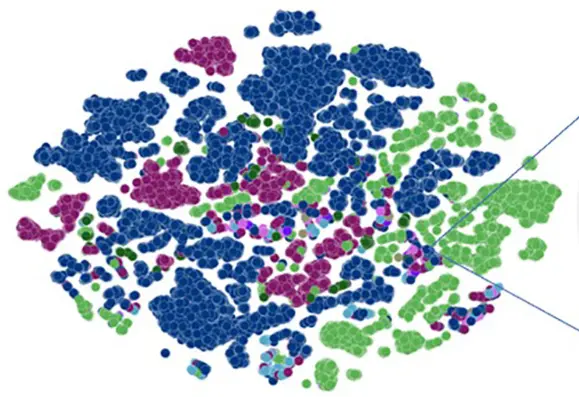For a more general look at foundation models and their application in science. Check out this brand new podcast interview with Ian Foster of Argonne National Laboratory and the University of Chicago. Full episode available here: https://scienceinparallel.org/2025/02/ian-foster-exploring-and-evaluating-foundation-models/ or on your favorite 🎙️ platform. #HPC #AI
Covering computational science, high performance computing and the DOE national laboratories. Managed by the Krell Institute. Banner info: http://bit.ly/3VdoeqR
Foundation models, an AI type that includes LLMs, could help researchers fortify defenses against infectious diseases. Arvind Ramanathan of Argonne National Laboratory and his team are applying their award-winning strategy for modeling SARS-CoV-2 evolution toward a more general approach for understanding viruses and bacteria. https://ascr-discovery.org/2025/02/disease-watch/ #HPC #LLM #infectious_disease
Superdiamonds could represent a novel, harder form of carbon that might exist in the cores of exoplanets. Ivan Oleynik and his University of South Florida colleagues have used Oak Ridge National Laboratory's Frontier supercomputer to study how this structure could form. The work is supporting experiments at Lawrence Livermore National Laboratory's National Ignition Facility. https://ascr-discovery.org/2025/02/hard-target-2/ #HPC
Fourth-year #DOECSGF recipient Rahul Sahay of Harvard University is using #quantum behavior to understand matter's phases and develop strategies to create new ones in the laboratory. https://deixismagazine.org/2025/02/sculpting-nature/
Cosmic rays—accelerated atomic nuclei driven by astrophysical phenomena—provide ways to study how galaxies evolved. Using exascale computing power and an #INCITE award researchers are modeling both large- and small-scale behavior in these systems and developing a new model that accounts for unexplained turbulence. https://ascr-discovery.org/2025/02/untangling-the-cosmos/ #HPC #OLCF #ALCF
Simulations to study new ways to catalyze hydrogen production could help with energy storage. Harvard University's Boris Kozinsky and his team are using machine learning to accelerate these complex calculations. https://ascr-discovery.org/2025/01/carbon-free-hydrogen/ Their #INCITE award includes allocations at both #ALCF and #OLCF. #HPC
New 🎙️ episode: the Science in Parallel podcast is wrapping up Season 5 with computational scientists Mansi Sakarvadia of the University of Chicago and Josh Vermaas of the MSU-DOE Plant Research Laboratory discussing how AI and the recent Nobel Prizes are shaping science. https://scienceinparallel.org/2025/01/computational-scientists-discuss-the-2024-nobel-prizes/ #DOECSGF #HPC
Alex Ballow of Montana State University-Bozeman uses category theory, a form of universal mathematical language, to probe patterns in physics that could advance #quantum computing, condensed matter physics and more.
https://deixismagazine.org/2025/01/categorical-imperative/# The #DOECSGF recipient completed practicum research at Oak Ridge National Laboratory.
New on the Science in Parallel podcast 🎙️ : @anil talks about AI's Nobel Prize year and his book Why Machines Learn. Listen on your favorite platform or here: https://scienceinparallel.org/2024/12/anil-ananthaswamy-ais-nobel-moment/ #HPC #AI #nobel2024
The human brain's trillions of connections remain largely uncharted. But a team from Argonne National Laboratory and Harvard University is using advanced electron microscopy and #ALCF's hardware and machine learning tools to map neurons' links to better understand how they interact https://ascr-discovery.org/2024/12/connecting-the-neurodots/ #HPC
An initial interest in cars led
Victor Zendejas Lopez to study turbulence using computational fluid dynamics at Caltech and Lawrence Livermore National Laboratory. Read more about his #DOECSGF-supported
research and how mentoring has shaped his career. https://deixismagazine.org/2024/11/predicting-chaos/ #HPC
As large language models get bigger, they're increasingly difficult to train. But a team led by Abhinav Bhatele of University of Maryland has developed the open-source #AI training framework, AxoNN, which distributes the work across multiple GPUs. https://ascr-discovery.org/2024/11/we-the-ai-trainers/ The work is nominated for a 2024 ACM, Gordon Bell Prize at #SC24 and has been supported by an #INCITE allocation at #OLCF and #ALCF.
Lithium-ion batteries rely on stable, functional electrolytes to store energy. The University of Michigan's Venkat Viswanathan is leading a team building a foundation model to design better electrolyte recipes that could be useful for many chemistry applications. https://ascr-discovery.org/2024/10/ai-turbocharge/ #HPC #renewableenergy #ALCF #LLM
During the pandemic, Margaret Cheung pivoted to a career modeling the molecular mechanisms of disease transmission at Pacific Northwest National Laboratory. Using a digital twin of the process, she's helping to grapple with complex biological data and find new strategies to disrupt infections. https://ascr-discovery.org/2024/10/pandemic-preparedness/ #HPC #OLCF #ALCF #NERSC
New 🎙️ episode: Paulina Rodriguez of
George Washington University discusses her quest to become an authentic scientist and her applied math career focused on the credibility of computational models. Check out the whole episode: https://scienceinparallel.org/2024/10/paulina-rodriguez-building-credibility-and-authenticity/ #HPC
Luis Rangel DaCosta of UC Berkeley has used machine learning to speed up the tedious analysis of high-resolution, atomic-level images. Read more about Construction Zone, the software package he and his colleagues developed "like computer-aided design, but for atoms." https://deixismagazine.org/2024/09/exploring-electrons/ #HPC #DOECSGF
New Science in Parallel podcast episode 🎙️: Paul M. Sutter talks about his many career hats: astrophysicist, host, author, and much more. We also discuss his most recent book, Rescuing Science, which critiques the scientific enterprise, and we discuss how science might return to its most essential core values: https://scienceinparallel.org/2024/09/paul-sutter-spaceman-adventures-in-science-and-outreach/
ICYM, the most recent Science in Parallel podcast episode 🎙️ features Rogelio Cardona-Rivera of the University of Utah discussing their research "playing games for science." Check out the full episode at https://scienceinparallel.org/2024/08/rogelio-cardona-rivera-plays-games-for-science/ #HPC
“One of the things that's really great about the #DOECSGF is it pairs you with labs that are currently in need of tools that can be deployed,” says Ariel Kellison. The Cornell University Ph.D. student studies formal methods, computational tools that can be used in a range of settings such as medical devices and military applications to make sure that software functions as expected. She’s also worked Sandia National Laboratories in California. https://deixismagazine.org/2024/08/subduing-software-surprises/ #HPC @davidbindel
New Science in Parallel #podcast episode 🎙️: Rogelio Cardona-Rivera talks about playing games for science. Learn about technical games research and its many components and applications in #AI, #storytelling platforms and #education. https://scienceinparallel.org/2024/08/rogelio-cardona-rivera-plays-games-for-science/ #HPC #DOECSGF #creativity
